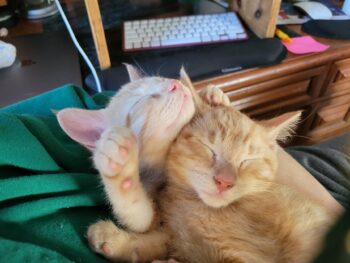 By Nicholas Tangen
By Nicholas Tangen
My spouse, Kristin, had often joked (or so I thought) that when we finally had to say goodbye to our elderly cat, Wallace, that she would need two kittens to compensate for the loss. It turns out she was not joking, and in early January we adopted two orange kittens named Alfie and Russ.
I put on my best Do we really need two cats? face while Kristin ordered cat-toys and treats and seemingly every cardboard cat shelter that Petco had to offer. I grumbled as it became more and more difficult to move in our house without tripping over some cat accessory. And I put up a decent argument for why my home office was definitely not the best place for them to live for the first couple of months. I lost that one.
But then, these two little kittens showed up. Have you ever tried to stay grumpy or annoyed with a two-pound kitten passed out and purring on your lap? Nearly impossible. I had to admit that my little Grinch heart grew a few sizes that day.
So, for the last couple of weeks, we’ve been adjusting our home and our routine to include Alfie and Russ. Kristin works in my office, where she can get all the kitten time she could ever ask for, and when I’m working from home I pop in every hour or so to steal a few minutes with them. In the evening, when we say compline together, everyone gathers in the office and the kittens do their best to disrupt our quiet.
“I had to admit that my little Grinch heart grew a few sizes that day.”
Last week, while we were praying, I was reminded of a Buddhist folktale I heard many years ago. For the life of me, I can’t find where it originated, but here’s a version:
where it originated, but here’s a version:
When the spiritual teacher and his disciples began their evening meditation, a cat who lived in the monastery made such noise that it distracted them. One day the teacher ordered that the cat be tied up during the evening practice.
Years later, when the teacher died, the cat continued to be tied up during the meditation session. And when the cat eventually died, another cat was brought to the monastery and tied up. Centuries later, learned descendants of the spiritual teacher wrote scholarly treatises about the religious significance of tying up a cat for meditation practice.
AS I RELAYED THIS STORY TO KRISTIN, I was struck by how quickly we had developed routines, habits, and best practices to adjust to life with our new cats. Kristin knows that the boys like to nap around the same time every morning, so she picks them up before they even take a step in her direction. When I complete a task at home, I very instinctually walk upstairs to play. When we say compline, we pick up all the little noisy cat toys. These routines developed so quickly!
Of course, the point of the Buddhist folktale is much more significant than simple cat ownership. The point is that our habits and practices, our cultures, which often develop in earnest and with clear intention, can over time become disconnected from their original intent. If we are not careful, we can be tempted to transfigure the mutable and usual into the sacred and eternal.
“If we are not careful, we can be tempted to transfigure the mutable and usual into the sacred and eternal.“
Each of our churches has developed a culture over time. I wonder how often we ask ourselves about the routines, the habits, and  the practices that we hang on to because “that’s the way we do things.” Very few practices are self-justifying and I’m willing to bet that if we get curious and try to understand the ins and outs of our church culture, we might find some things that just don’t make sense anymore.
the practices that we hang on to because “that’s the way we do things.” Very few practices are self-justifying and I’m willing to bet that if we get curious and try to understand the ins and outs of our church culture, we might find some things that just don’t make sense anymore.
I know that I’m going to keep asking myself these questions in my congregation and at the Synod. I’d challenge you to do the same.
Now, it’s about time for me to go check on Alfie and Russ. Peace!
